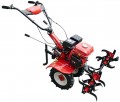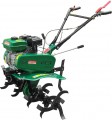Design
—
Power take-off shaft. The presence of a power take-off shaft in the design of a two-wheel tractor. Such a shaft provides the transmission of rotation from the engine to additional equipment used with a two-wheel tractor — seeders, mowers, mulchers, harvesters and other units that require a mechanical drive for operation. Thus, this function significantly expands the capabilities of the two-wheel tractor and the range of equipment compatible with it. On the other hand, it complicates the design, increases its weight, and most importantly, the price. It is also worth considering that different external units may have different types of tails for the power take-off shaft and different requirements for rotation speed; compatibility on these points must be clarified separately.
—
Power take-off pulley. The function is similar to that described above — the power take-off shaft. A distinctive feature is its location and, accordingly, the method of hanging additional equipment. The shaft is located behind the rear end, while the pulley is on the side of the housing.
—
Transport wheels. The presence in the design of the cultivator / two-wheel tractor of a special wheel (wheels), facilitating the transportation of the unit during non-working hours. In cultivators, such wheels allow you not to drag the device directly on the ground (which can damage the working tool) or
...in your hands (which is inconvenient due to the large weight), and in two-wheel tractors they provide an additional point of support for both moving and parking. These wheels should not be confused with the main wheels of the device: the unit moves to the main wheels during operation (and in many models — all the time), while the transport wheels are used exclusively during non-working hours.
— Reverse. The possibility of moving the unit in reverse — for this, the direction of rotation of the wheels or the cutter is reversed. This function gives additional features for manoeuvring; it is especially useful in heavy equipment that would be inconvenient to pull on yourself manually.
— Differential lock. The ability to turn off the differential in the two-wheel tractor is a special mechanism designed to “coordinate” the movement of the wheels with each other when turning. The differential is necessary for normal handling on relatively flat ground, but it worsens the overall patency — these are the technical features of the mechanism. Therefore, in some two-wheel tractors, it may be possible to block the differential; this can be useful both in rough terrain and in some jobs with high and uneven wheel loads.
— Protections for plants. Special devices, also called "cutting guards". They usually look like two metal discs on either end of the axle where the cutters are located. These discs prevent plants from getting into the working tool and allow you to work the land in the immediate vicinity of already planted plants without fear of damaging them with the cultivator's cutters. You should definitely pay attention to the presence of such protection if you are going to use the device for inter-row cultivation.
— Height adjustable handle. The ability to change the height at which the handles of the two-wheel tractor are located. This feature is designed to adjust the handles to the height of the operator — for people of different heights, the most comfortable height will also be different.
— Lateral rotation of the handle. The ability to turn the handle of the two-wheel tractor to the side — so that the operator can go not behind the unit, but next to it. This function will be useful in cases where it is inconvenient or undesirable for the user to be behind the two-wheel tractor — for example, if it is impossible to trample on cultivated land, if the applied nozzle throws soil or grass back, or if this nozzle protrudes strongly backwards, and because of it it is not up to the handles reach out.
— Headlights. The presence of headlights will allow you to work with a cultivator / two-wheel tractor, regardless of the time of day and external light sources — in the dark, just turn on the headlights. They may also be required when using a two-wheel tractor as a tractor — both at night, and in some other cases provided for by traffic rules.Reducer
The type of gearbox provided in the design of the two-wheel tractor.
The gearbox is a mechanism for transmitting rotation from the motor shaft to the working shaft; the speed of rotation is reduced, and the tractive effort, respectively, increases. In modern units,
worm,
chain,
gear and
gear-chain gearboxes can be used; here are their main features:
— Worm. Gearboxes based on a worm gear are mainly used in light two-wheel tractors with passive cutters (motor cultivators). With simplicity and low cost, such a gearbox provides a high gear ratio, which makes it possible to achieve good traction at a relatively low engine power. Other advantages of worm gears include compactness, minimum noise level, smooth running and self-braking ability. On the other hand, such gearboxes do not tolerate high loads, which determined the scope of their application.
— Chain. Gearboxes based on a chain drive — two gears connected by a chain (similar to the mechanism used in bicycles). Such gearboxes are somewhat more expensive than worm gears, but they are more reliable and able to work with higher loads. Another advantage lies in the small width of the body, which is especially important for motor cultivators — the gearbox does not limit the depth of processing, since it can be buried in the soil simultaneously with the cutters.
...— Geared. The most advanced type of modern gearboxes. Such mechanisms are highly reliable and durable, they normally endure long-term work at high loads. The downside of these advantages is the high price. Gear reducers are used mainly on professional equipment, for which "endurance" is critical.
— Gear-chain. A compromise option, which, when installed on a motor cultivator, increases its performance (compared to chain and worm), and when installed on a motor block, slightly reduces the cost of the latter.Number of gears
The number of gears provided in a self-propelled cultivator / two-wheel tractor, in other words, the number of travel speeds. There are both the simplest
two-wheel tractors for 1 gear or
2 gears, as well as more advanced ones with
three,
four and even
6 gears. Lower gears are not fast, but they allow you to effectively cope with high loads, and are also better suited for starting from a place; higher ones give low tractive effort, but good speed. Thus, the presence of several gears makes it possible to adjust the operating mode of the unit to the specifics of the situation. The number of gears is also relevant for reverse gear, because there are walk-
behind tractors and cultivators for 1 gear or
more.
Engine size
The working volume of the gasoline or diesel engine of the cultivator / two-wheel tractor. For an internal combustion engine of the same type (see "Type of internal combustion engine"), power and fuel consumption usually directly depend on the volume. Also, the classification of a two-wheel tractor as a vehicle according to the traffic rules of a particular country may depend on the engine volume; you should pay attention to this if you plan to use the unit as a tractor and drive on roads.
Motor power
Horsepower of two-wheel tractor/cultivator motor. The basic unit of power nowadays is watt, however for petrol and diesel engines (see "Motor type") the more traditional designation in horsepower is often used. 1 hp is approximately equal to 735 watts.
More powerful motor allows achieving higher productivity, width and depth of processing. On the other hand, high power significantly affects the price, weight and dimensions of the unit, as well as the consumption of electricity/fuel. In light of this, the engine characteristics are selected by the manufacturer taking into account what "weight category" the walk-behind tractor belongs to. The most limited modern units have a power of
up to 2 hp, in the heaviest and most advanced this figure can
exceed 13 hp ;
4 - 7 hp can be called an average indicator, and
2 - 4 hp and
7 - 13 hp are below and above average, respectively.
Detailed recommendations on the optimal power for a given situation can be found in specialized sources.
Motor power
The power of the two-wheel tractor/cultivator engine in watts. This designation is usually used for electric engines, but can also be used for petrol/diesel engines, along with horsepower (for more information, see the "Motor power" section above).
More powerful motor allows achieving higher productivity, width and depth of processing. On the other hand, high power significantly affects the price, weight and dimensions of the unit, as well as the consumption of electricity / fuel. In light of this, the engine power is selected by the manufacturer taking into account what "weight category" the walk-behind tractor belongs to, what characteristics it should show. So, the lightest models have a power
of up to 1.5 kW, this is the device that is best suited for a small area of 6 - 8 acres. Walk-behind tractors
up to 3 kW can cope with 10 - 15 acres, a power of
3.5 - 5 kW is suitable for a plot of 50 acres to a couple of hectares. Units
for 5 - 10 kW are already classified as professional level, they can "tame" spaces of 7 - 10 hectares; and the heaviest and most powerful modern walk-behind tractors have a power
of more than 10 kW.
Fuel consumption
The average amount of fuel consumed by the gasoline or diesel engine (see "Engine type") of the cultivator/two-wheel tractor per hour of operation. This value is rather conditional, because depending on the mode of operation, fuel consumption may vary in one direction or another; however, in general, it provides an estimate of the approximate amount of fuel required for a given operating time.
Fuel tank volume
The volume of the fuel tank of the cultivator / two-wheel tractor; knowing this parameter and fuel consumption (see above), it is possible to determine the maximum operating time of the unit on a single refill. If you plan to use the device in large areas or to work for a long time, it makes sense to look for a model with a large tank — it will not have to be filled often. On the other hand, for short-term work in small areas, a large tank is not required — in this case, it only increases the weight and dimensions of the unit.
Noise level
The maximum noise level produced by the cultivator / two-wheel tractor during operation. A noise of 70 dB is comparable to a very loud conversation, 80 dB to a busy city street, 100 dB to a production shop. The lower the noise level, the more comfortable the use of the unit for the operator himself and the less inconvenience it causes to others.

